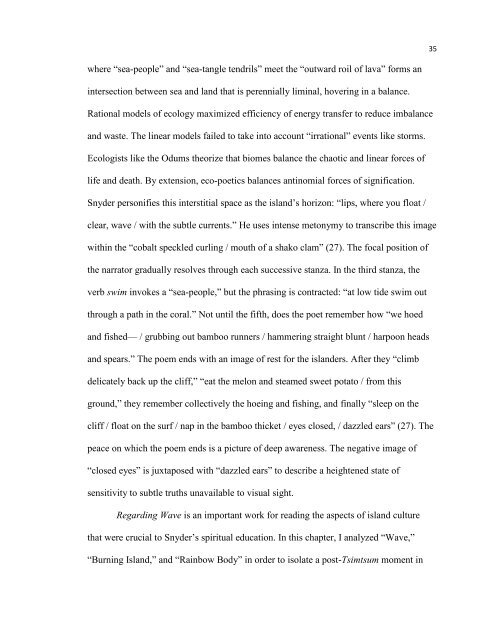RE-INHABITING THE ISLANDS - The University of North Carolina at ...
RE-INHABITING THE ISLANDS - The University of North Carolina at ...
RE-INHABITING THE ISLANDS - The University of North Carolina at ...
Create successful ePaper yourself
Turn your PDF publications into a flip-book with our unique Google optimized e-Paper software.
35<br />
where ―sea-people‖ and ―sea-tangle tendrils‖ meet the ―outward roil <strong>of</strong> lava‖ forms an<br />
intersection between sea and land th<strong>at</strong> is perennially liminal, hovering in a balance.<br />
R<strong>at</strong>ional models <strong>of</strong> ecology maximized efficiency <strong>of</strong> energy transfer to reduce imbalance<br />
and waste. <strong>The</strong> linear models failed to take into account ―irr<strong>at</strong>ional‖ events like storms.<br />
Ecologists like the Odums theorize th<strong>at</strong> biomes balance the chaotic and linear forces <strong>of</strong><br />
life and de<strong>at</strong>h. By extension, eco-poetics balances antinomial forces <strong>of</strong> signific<strong>at</strong>ion.<br />
Snyder personifies this interstitial space as the island‘s horizon: ―lips, where you flo<strong>at</strong> /<br />
clear, wave / with the subtle currents.‖ He uses intense metonymy to transcribe this image<br />
within the ―cobalt speckled curling / mouth <strong>of</strong> a shako clam‖ (27). <strong>The</strong> focal position <strong>of</strong><br />
the narr<strong>at</strong>or gradually resolves through each successive stanza. In the third stanza, the<br />
verb swim invokes a ―sea-people,‖ but the phrasing is contracted: ―<strong>at</strong> low tide swim out<br />
through a p<strong>at</strong>h in the coral.‖ Not until the fifth, does the poet remember how ―we hoed<br />
and fished— / grubbing out bamboo runners / hammering straight blunt / harpoon heads<br />
and spears.‖ <strong>The</strong> poem ends with an image <strong>of</strong> rest for the islanders. After they ―climb<br />
delic<strong>at</strong>ely back up the cliff,‖ ―e<strong>at</strong> the melon and steamed sweet pot<strong>at</strong>o / from this<br />
ground,‖ they remember collectively the hoeing and fishing, and finally ―sleep on the<br />
cliff / flo<strong>at</strong> on the surf / nap in the bamboo thicket / eyes closed, / dazzled ears‖ (27). <strong>The</strong><br />
peace on which the poem ends is a picture <strong>of</strong> deep awareness. <strong>The</strong> neg<strong>at</strong>ive image <strong>of</strong><br />
―closed eyes‖ is juxtaposed with ―dazzled ears‖ to describe a heightened st<strong>at</strong>e <strong>of</strong><br />
sensitivity to subtle truths unavailable to visual sight.<br />
Regarding Wave is an important work for reading the aspects <strong>of</strong> island culture<br />
th<strong>at</strong> were crucial to Snyder‘s spiritual educ<strong>at</strong>ion. In this chapter, I analyzed ―Wave,‖<br />
―Burning Island,‖ and ―Rainbow Body‖ in order to isol<strong>at</strong>e a post-Tsimtsum moment in
















